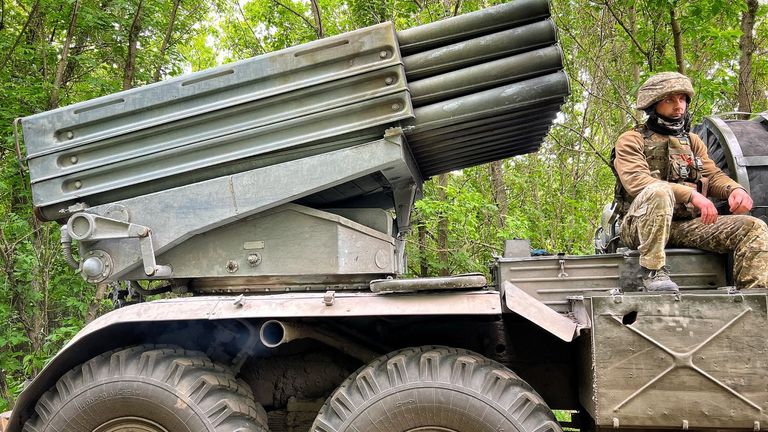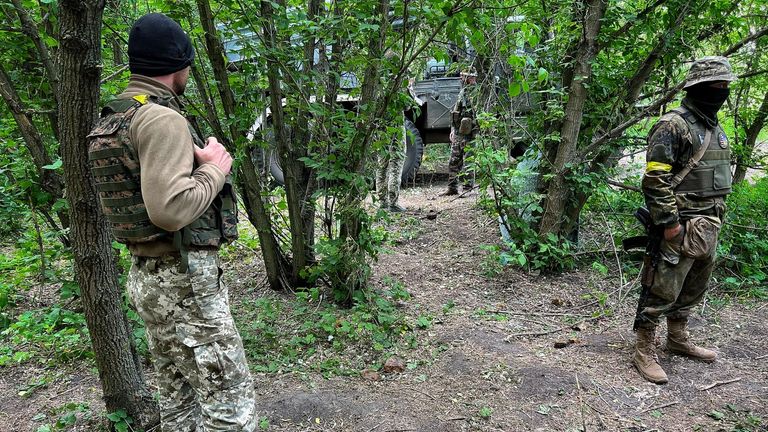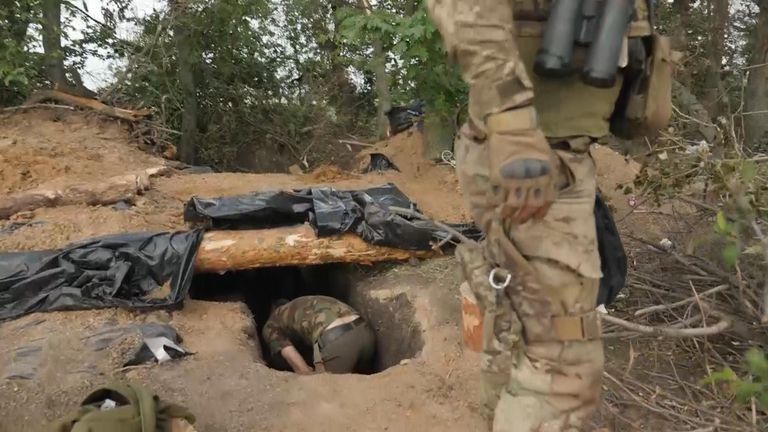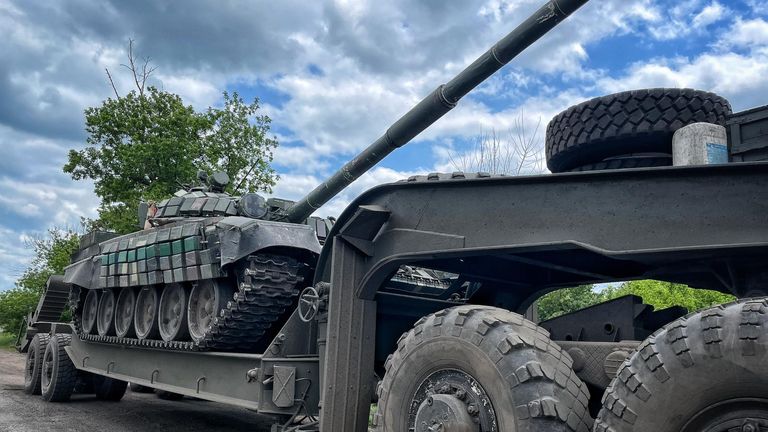[ad_1]
We’re deep in the Ukrainian forest, hidden by a thick canopy of trees and foliage.
We’ve been given rare access to one of the country’s most valuable military assets in action in this brutal war.
The Ukrainian soldiers from the 93rd Brigade, who we’re with, are awaiting their orders.
Kremlin hits back at rumours Vladimir Putin is terminally ill – Ukraine news live
They’re prepared for a long spell in the forest if needs be and have built some napping areas – hideouts created with twigs, branches, and leaves which offer natural camouflage.
To be spotted by their Russian enemies would wreck their mission and endanger their lives.
Invisibility is key in their role.
Parked up and half-submerged in a bush is their prized weapon.
She is a 60-year-old veteran, but the Ukrainians believe she is critical in this long-distance war, and she’s tended to constantly by the soldiers whilst we are there, like the precious resource they believe her to be.
She’s an old multiple rocket launcher from the Soviet era – built in the 60s but still operating with devastating effect.
Her full load is 40 122mm missiles, which can be fired on a target 20km (12.4 miles) away in under 20 seconds.
They deliver a massive explosive package and can cause huge destruction and fragmentation over a wide area, capable of destroying whole enemy positions but also entire villages in a matter of minutes.
‘Hailstorm’ of explosives
Both sides in this bloody conflict have been criticised by human rights activists for using weapons like these.
They’re called grads – the Russian word for “hail” and they can shower a “hailstorm” of explosives indiscriminately over large areas.
They are not viewed as precision weapons.
But in this war, Russia is deploying its long-range artillery arsenal to savage effect in the Donbas region and has the numerical advantage.
Ukraine’s stock is dwarfed by their enemy’s – leading to repeated calls by troops and the country’s President Volodymyr Zelenskyy for more long-range weapons from their foreign partners.
The American-made much younger Multiple Launch Rocket System (MLRS) is considered to be far more sophisticated and far more precise.
It also has a much longer range and can hit targets hundreds of kilometres away.
But right now, the old Soviet veteran is what the 93rd Brigade has at its disposal, and they need her.
The crew get their orders to shift and suddenly there’s action.
They move quickly to get into the rocket launcher and drive quickly off down dusty, forest routes to avoid being seen by Russian drones.
The crew move into a field and within minutes they’ve set up the sights and are positioning the rockets.
“Fire 20” are the orders.
The first 20 rockets are launched with a thundering shudder of a noise wave that moves through your body right down to your feet and soles.
Those anywhere near the receiving end will hear a terrifying howl before crashing thuds as they land.
“Fire 20” – the order comes again, and the second load is fired off.
It’s only been a matter of minutes, but the crew is already on board again and racing out of the field and away before the expected return attack comes in.
‘It’s not safe here’
Dotted around the south of the town of Izyum are multiple groups of troops trying to stop the Russians from advancing south to attack the Donbas region from another front.
We travelled out at speed with “Chief” from the 93rd, across frighteningly exposed farmland and Russian lines about 4km (2.5 miles) away.
We could see clouds of smoke rising from several Russian positions as our vehicle careered across fields and sandy tracks until we reached a small cops.
Slightly bedraggled and exhausted-looking soldiers with grubby faces greeted us.
“It’s not safe here,” are the first words that Ivan says to us as we meet him.
It seems they’ve been recently shelled, about an hour or two before our arrival.
It’s not unusual, they say they’re regularly shelled, repeatedly throughout every day.
The Russian troops don’t seem to be moving much in this area.
Ukrainian soldiers demonstrate gratitude to Britain
Ivan proudly shows us some of the weapons delivered to them by their foreign allies and pulls out an N-law.
“It’s British,” he says and grins.
The troops and civilians often say “God save the Queen to us” when they realise we are British, to demonstrate their gratitude for the weapons the UK has sent over.
N-laws have been particularly potent.
They’re designed to destroy tanks at short range with a single shot.
But Ivan tells us in their position they’ve been less use.
Read more:
‘My child has gone, and I’m so sad’
French journalist killed in Ukraine
EU meets to discuss Russian energy ban
“Their (Russian) tanks don’t come closer than three and a half kilometres and this weapon can’t reach the target at that distance effectively,” he says.
They have had some successes recently and point out the destroyed Russian tanks and other military vehicles over the other side of a stretch of water.
It shows how close they are getting before being halted, and the Ukrainians fully expect them to mount further attacks to push forward unless they can halt them and for that, they say, they need many more weapons.
“We need tanks and more artillery,” Ivan says, echoing what every senior Ukrainian official including the president seems to be saying right now.
Subscribe to Ukraine War Diaries on Apple Podcasts, Google Podcasts, Spotify and Spreaker
It appears the Russians have learnt from their earlier failures, in trying to encircle the capital Kyiv and the second city Kharkiv.
They’ve adapted their tactics and are throwing men and machines with long-range capabilities towards smaller targets in eastern Ukraine and the Donbas region.
And they’re doing this at a distance, forcing both sides to pound villages and towns in a brutal battle to gain the upper hand.
:: Alex Crawford reports from the Eastern Ukraine front lines with cameraman Jake Britton and producers Chris Cunningham and Artem Lysak, Nick Davenport and Misha Cherniak
[ad_2]







